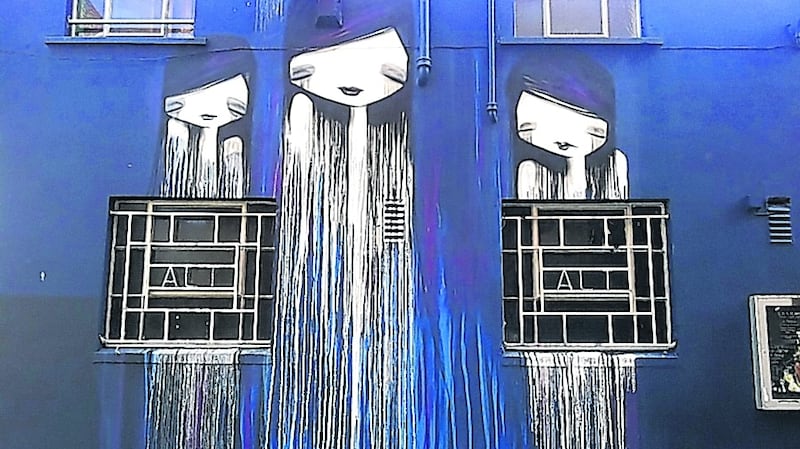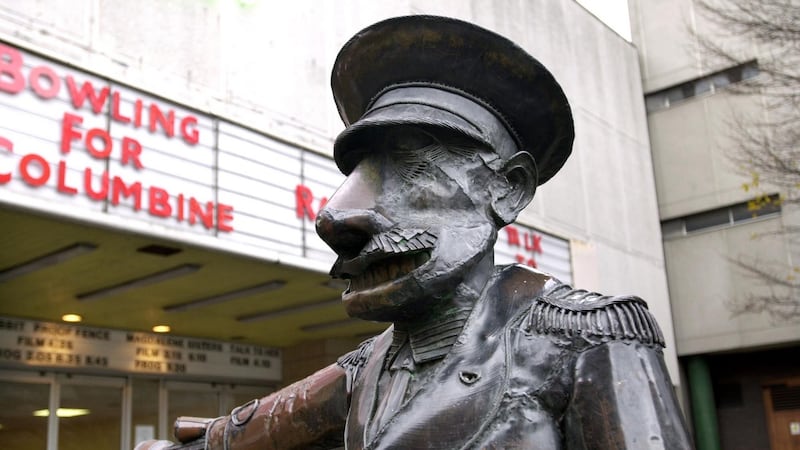How do you point out what isn’t there any more?
When Willie White, the director of the Dublin Theatre Festival, counts off the theatre spaces that no longer exist, it sounds like a map drawn from memory: the rickety City Arts Centre; the musty Crypt; the storied SFX (apartments), the Tivoli (apartments), Andrew's Lane Theatre (aparthotel), the Theatre Space at Henry Place (who knows?).
“If you look around, objectively there are fewer spaces than there were 20 years ago,” says White, whose career began at the Crypt, in 1996, with Loose Canon. “So when we hear people complaining, it is with good reason. The theatres, the people running club nights, the people running markets, anything that’s independent, under the radar, not necessarily commercial, it’s all being squeezed out.”
Don't it always seem to go that you don't know what you've got till it's gone, sang Joni Mitchell in 1970. The disappearing act of venues and cultural spaces in the city can similarly feel like a familiar tune, draining the situation of urgency. "It's going to be a crisis," Vanessa Fielding, the director of the Complex told me, as though hesitant to confirm it now. She can also compile a list of vanished arts and culture spaces: The Ormond Multimedia Centre, The Focus Theatre, Lombard Street Gallery, the Eblana Theatre beneath Busaras ("That used to be a mad one!"). She turned over the page to count new venues. "On the new list is The Lir," she said of Trinity College's academy. "And then I got stuck."
Staple venues
If you're a festival programmer you could be forgiven for feeling like you're in a similar position. "The things that artists ask me for that I can't provide are things like warehouses and shop fronts," says Ruth McGowan, the director of the Dublin Fringe Festival, noting that these staple venues in other capitals have already been claimed for building new cathedrals of finance, as is the case with Dublin's Docklands. "I'm amazed by the buildings that are shooting up around it," marvelled Ray Yeates, the City Arts Officer, when asked if the Docklands had anything to provide for cultural use. "It's too late," he says.
When they've done their work and made somewhere interesting and trendy, it's the artist that gets booted out
Still, the area can give a revealing performance of its own. To visit the Docklands outside office hours, and especially during the weekend, is to walk through a pristine, glass-fronted ghost town in the middle of the city.
“The whole city is in the grip of a space crisis,” says McGowan. “Everything is incredibly expensive . . . I think it’s quite telling that people who want to make shows in cafes, hotels or car parks – a staple of festivals all over the world – are saying to us that they can’t find anywhere to host them. Of course, these are privately owned spaces and the city is really busy. Everything is at maximum occupancy. You’d think it would be easier to find a coffee shop to put a show on in, than to put a show on in the Four Courts [as one Fringe show, The Justice Syndicate, does]. But that’s not necessarily true any more.”
Fringe theatre has generally served as a barometer of the times. The sprawling promenade shows through the concrete and steel playgrounds of the Block T venue, which opened in in 2010 within a stalled development in Smithfield, suggested that property is usually more accommodating for artists when it cannot be put to other uses. A similar theory is that artists are seen as a positive force for gentrification. “Then, when they’ve done their work and made somewhere interesting and trendy, it’s the artist that gets booted out,” says McGowan. “That’s been happening since forever.”
Red Squirrel mural
Like Artur Bordalo’s striking Red Squirrel mural on the corner of Tara Street, recently cleared to prepare for the development of another hotel, it’s a removal that rankles. “You need to look after the people who make the city special, who make the city tick,” says McGowan, “and make space for them.”
One show in the Fringe this year, We Are Lightning!, even imagines the last night of the last music venue in town. (Which former patrons of Mabos, the Joinery or Hangar may not believe is an unrealistic forecast.)

Do we want a city with artists in it, or do we want them pushed out to the peripheries?
As a meditation on the erosion of communal spaces, We Are Lightning! also imagines culture’s last stand. “It’s sort of about gentrification and the importance of holding on to community spaces where people can come together, whether it’s music, dancing, performing or a space for artists to work in,” says McGowan. “Because I think this is top-of-mind stuff for people. There’s a real sense of precariousness, when the rent on your house is going up, your rehearsal space and you can’t afford your office any more. That’s a tricky context to make a life in, let alone to make art in.”
To Labour Dublin City councillor Rebecca Moynihan, a space for artists is the fundamental question. "Do we want a city with artists in it, or do we want them pushed out to the peripheries?" she says. If private developers don't immediately consider space for culture in their plans, legislation can make them. In 2016, Moynihan and Green Party councillor Claire Byrne tabled a motion to include in the Dublin City Development Plan a provision to increase the supply of studio and arts spaces in the council's mixed-use schemes. She points to the Poolbeg West Strategic Development Zone, which will reserve 5 per cent of its development for arts and cultural spaces. Among its 3,500 homes (900 of which are for social housing), that amounts to at least 40 artist studios.
Venerable and viable
It's an encouraging step, but, next to the recent closure of Broadstone Studios, both venerable and viable, and the redevelopment of Newmarket, from which the Dublin Flea Market has moved, it can also sound like one step forward next to two steps back. "There's never an 'arts emergency'," Moynihan agrees, "that's what our arts officer is always saying." Yet the situation seems critical.
“The department [of Culture, Heritage and the Gaeltacht] needs to be more strategic in terms of providing for long-term infrastructure,” says Moynihan. “For some reason the arts always falls out of that.”
On a bright afternoon last week, I walked through a corner of Smithfield under rapid redevelopment. The corner of Little Green Street and Mary Street, until recently home to the Complex, had been razed and cleared, now prowled over by diggers while awaiting a new life as a hotel and retail complex. Its director, Vanessa Fielding, found me in the nearby Dublin Fruit Market on one of its final days in operation, smiling over a handful of crates of oranges and lemons at the few remaining stall owners. “Come this way,” she said, leading towards Arran Street. “I’m hoping this will blow your mind.”

It's important that we make some kind of a stand. The voice of the artists in the cultural sector is so weak
The new site of the Complex, itself a former fruit warehouse, resembles a cultural oasis in a widening desert. Bought out of its 10-year lease, four years in, at its Green Street premises, and supported by Dublin City Council, the Department of Culture, and the Arts Council, the Complex became tenant of the new site last June and set about clearing the space of industrial banana fridges. It now houses an exhibition space, due to open on September 13th, terraced rows of artists' studios (all occupied), and a long, high, adaptable performance space. "Converting an old building into a place for public assembly is tough going," says Fielding. (Its opening date was pushed back from last March to this December.) But, against the odds, it is happening.
“It’s important that we make some kind of a stand,” says Fielding. “The voice of the artists in the cultural sector is so weak. The thing that makes Dublin so exciting, so sexy and everything is what we provide culturally, and if we have no space to do it beyond the national institutions, which is the likely thing, Dublin will just be full of hotels and student accommodation.”
Serendipity
The Complex owes its new lease of life (and its new lease) to serendipity as much as strategy: the building is privately owned and likely to be sold. “We’ve got three or four more years here,” Fielding reasons. “Then all the good work could dissipate, unless, say, the Department of Culture were to buy the site.”
She does not see that as an act of charity. “It would be advantageous for the area, which is bereft of a cultural service or facility in the north west inner city, and there’s obviously uptake. There’s a huge demand for studios and performance space, that flexible 300-350 capacity. Honestly, we’d be full all the time. Our model is good. The innards are working.”
No, nobody is going to die, but over time Dublin is going to become more boring, and less attractive to live in
When I spoke to Willie White, of the Dublin Theatre Festival, he was in Groningen, in the Netherlands, for the Nordezon Festival, watching crowds gather for art, entertainment and cultural exchange; immune it seemed, from the isolating conveniences of Deliveroo, Facebook and Netflix. He was loath to make comparisons, pointing out that Dublin's cultural infrastructure has been mostly unchanged since before Independence, that institutions from the Abbey to the Gate were themselves repurposed spaces. "But I'd love there to be some acknowledgement that there is a problem," White says. "Call it a crisis. No, nobody is going to die, but over time Dublin is going to become more boring, and less attractive to live in. My vision of the city is not one the people retreat from in the evenings and stay away from at the weekends. It's a place where people congregate. That to me is society-making."
That is the risk of a city advancing without a plan, in thrall to unchecked, unwise development. Imagine a Dublin beckoning with the gleaming promise of ever more aparthotels, which eventually finds itself with little to see and nothing to do.













